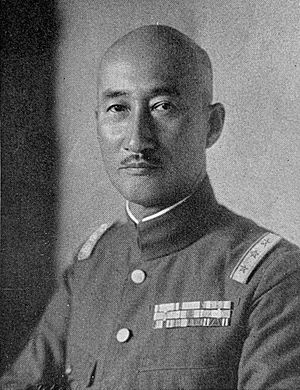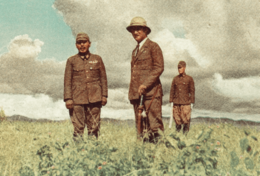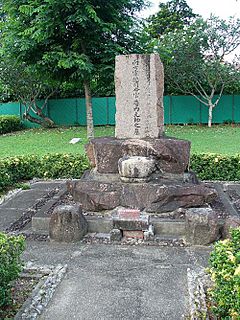Hisaichi Terauchi facts for kids
Quick facts for kids
Terauchi Hisaichi
|
|
|---|---|
|
寺内 寿一
|
|
 |
|
| Minister of War of the Japanese Empire | |
| In office 9 March 1936 – 2 February 1937 |
|
| Monarch | Shōwa |
| Prime Minister | Kōki Hirota |
| Preceded by | Yoshiyuki Kawashima |
| Succeeded by | Kotaro Nakamura |
| Personal details | |
| Born | 8 August 1879 Tokyo Prefecture, Japan |
| Died | 12 June 1946 (aged 66) Renggam, Johor Bahru, Malaya |
| Resting place | Japanese Cemetery Park, Singapore |
| Alma mater | Army War College |
| Military career | |
| Allegiance | |
| Service/ |
|
| Years of service | 1899–1945 |
| Rank | |
| Commands held | 5th Division 4th Division Taiwan Army of Japan Northern China Area Army Southern Expeditionary Army Group |
| Battles/wars | Russo-Japanese War
|
| Awards | Order of the Rising Sun (1st class) Order of the Golden Kite (1st Class) |
Count Hisaichi Terauchi (born August 8, 1879 – died June 12, 1946) was a very important military leader in Japan. He was a Field Marshal in the Imperial Japanese Army. During World War II, he was the commander of the Southern Expeditionary Army Group. This group was in charge of Japanese forces in Southeast Asia.
Contents
Biography
Early life and military training
Hisaichi Terauchi was born in Tokyo Prefecture, Japan. His father, Terauchi Masatake, was also a famous general and even served as the Prime Minister of Japan. When Hisaichi was young, he lived with his aunt for a while.
He decided to follow in his father's footsteps and joined the military. He graduated from the Imperial Japanese Army Academy in 1899. After his training, he served as a junior officer in the Russo-Japanese War. This war was fought between Japan and Russia from 1904 to 1905.
After the war, Terauchi continued his studies at the Army Staff College. He graduated in 1909. He also spent time in Europe, working as a military expert in Austria-Hungary and Germany. In 1919, he became a count, inheriting the title after his father passed away.
Rising through the ranks
Terauchi continued to rise in the army. He became a major general in 1924. Later, in 1927, he became the Chief of Staff for the Japanese army in Korea. He was promoted to lieutenant general in 1929.
In 1932, he was in charge of the 4th Division in Osaka. During this time, there was a famous event called the "Go-Stop Incident." It started when a soldier ignored a traffic light and argued with a policeman. This small argument grew into a big disagreement between the army and the police. Terauchi insisted that the police should apologize. In the end, it was decided that civilian police could not handle crimes committed by military personnel. This meant military members were treated differently under the law.
In 1935, Terauchi became a full general.
Becoming Army Minister
In 1936, after an event called the February 26th Incident (a military uprising), Terauchi became the Army Minister. This was a very important job. He worked to remove officers who had been part of the uprising.
He was known for speaking his mind. Once, he had a very heated argument with a member of the Japanese parliament. This argument caused the government to collapse.
Role in World War II
In 1937, when the Second Sino-Japanese War began, Terauchi was given command of the North China Area Army. He led Japanese forces in China.
In November 1941, just before the Pacific War started, Terauchi was put in charge of the Southern Expeditionary Army Group. This group was responsible for Japan's military actions in Southeast Asia. He worked closely with Admiral Yamamoto Isoroku to plan attacks.
Terauchi led the conquest of many areas in Southeast Asia. He set up his main office in Singapore. In 1943, he was promoted to Field Marshal, the highest rank in the Japanese army.
In 1944, he moved his headquarters to the Philippines. But as the Allied forces (like the US and Britain) began to win more battles, he moved to Saigon. In May 1945, he suffered a stroke (a serious medical event) after Japan lost control of Burma.
As World War II ended, Terauchi was too ill to formally surrender in person. So, another general surrendered on his behalf in Singapore in September 1945. Terauchi himself officially surrendered to Admiral Mountbatten in November 1945.
He suffered another stroke and died in June 1946 while being moved to a prisoner of war camp in Malaya. He was buried in the Japanese Cemetery Park in Singapore.
Terauchi's family owned a special short sword called a wakizashi. This sword, made in 1413, was given to Lord Mountbatten after the war. It is now kept at Windsor Castle in England.
See also
 In Spanish: Hisaichi Terauchi para niños
In Spanish: Hisaichi Terauchi para niños




